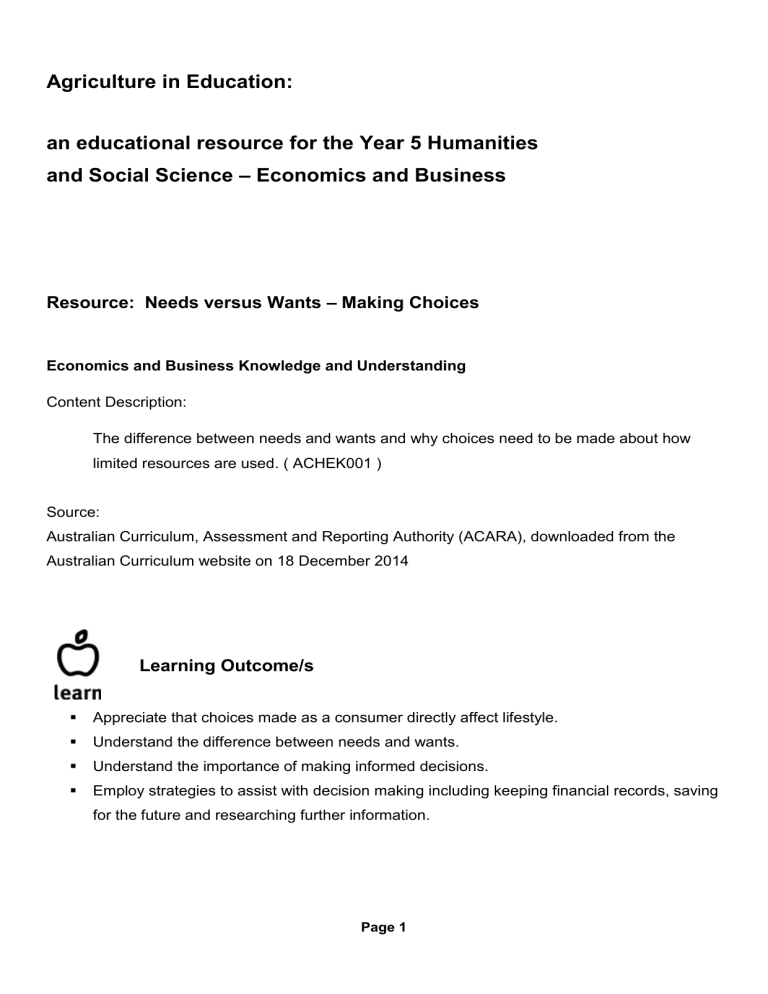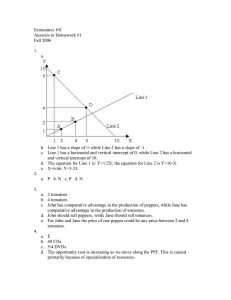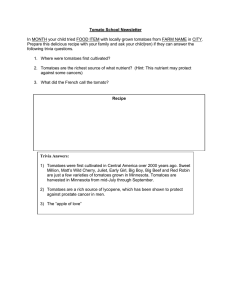
Agriculture in Education: an educational resource for the Year 5 Humanities and Social Science – Economics and Business Resource: Needs versus Wants – Making Choices Economics and Business Knowledge and Understanding Content Description: The difference between needs and wants and why choices need to be made about how limited resources are used. ( ACHEK001 ) Source: Australian Curriculum, Assessment and Reporting Authority (ACARA), downloaded from the Australian Curriculum website on 18 December 2014 Learning Outcome/s Appreciate that choices made as a consumer directly affect lifestyle. Understand the difference between needs and wants. Understand the importance of making informed decisions. Employ strategies to assist with decision making including keeping financial records, saving for the future and researching further information. Page 1 Description This resource provides activities where students must make decisions about consumer items based upon their available resources and understanding of needs and wants. Overview To place these activities into context for students and to support the learning outcomes around decision-making it is suggested that teachers read the story of “Kyle and Kira and the Tomatoes” to the class and facilitate a discussion as described in Setting the Scene. The Kyle and Kira and the Tomatoes can be found at the end of the resource. Work Task 1 Ask students to define what needs and wants are. For example: Needs are things that we cannot live without and Wants are things we can live without but we would like. This leads on to discussion and decision-making whereby students are asked to consider from a list of goods which of the items are ‘needs’ and which are ‘wants’ for four different people with different backgrounds and jobs. Work Task 2 Students participate in a Needs and Wants Game where the aim is to enhance lifestyle by purchasing consumer goods according to perceived needs while restricted by a limited budget. This task provides support for each of the learning outcomes identified in the resource. Page 2 Setting the Scene Read the story of Kyle and Kira and the Tomatoes to the class and discuss how the bicycle was a “want” and the seeds and fertilizer were “needs” that developed. Teachers should lead the discussion to highlight how Kyle and Kira kept track of their finances, how they were saving for the future and how further research about the market and most suitable tomatoes would have helped them in their enterprise. Work Task 1 This activity is best conducted with students working in small groups of 3 or 4. Distribute a copy of worksheet 1 to each group. Give students a few minutes to discuss and write their definitions of needs and wants. Groups should then be asked to share their definitions with the class. Depending upon groups’ abilities, teachers may ask groups to complete the list of needs and wants for one, two or all of the four characters on the worksheet. Allow time for discussion within the groups. Lastly, groups must provide justifications for what they believe are the needs and wants of the characters. This might be undertaken by pairing groups and asking them to share, compare and provide a consolidated list of needs and wants; or as a whole class share lists on a whiteboard or through digital means to a smartboard. Work Task 2 This is a fun activity that requires students being able to use simple addition and subtraction up to thousand ( 1000 ). Calculators will make the task move more quickly. The game is called the Needs and Wants Game and students each play the role of a fisherman having to purchase all the necessary items needed to live and make a living. The aim of the game is to improve the lifestyle of the fisherman by making sensible choices, that is spending wisely and saving. There is a list of items that students must choose from on Worksheet 2. Page 3 To play the game the teacher will need a single dice and each student will require worksheets 2 and 3. The game instructions are on worksheet 2. To begin, read the instructions to the class. Explain that “credits” is the currency that is used in the game and each “month” is represented by the teacher’s dice roll. The first thing all students must do is make their purchases starting with 200 credits by recording purchases on worksheet 3 and adding up the total spend. They do not have to spend all the 200 credits. Anything not spent is a savings that they can carry over to the next month. There may well be quite a lot of discussion about the items that student have to choose from and what they consider to be a need and a want. Teachers should allow students to form their own opinions about this without too much comment. What might be a need or want will be revisited after the game has been played, when strategies that inform decision making should be more obvious to students after reflecting upon what happened in the game. Online Teacher support resources: This is a useful resource – Consumer Stuff for Kids A teaching and learning resource produced by the Victorian Department of Consumer Affairs – consumer.vic.gov.au. Page 4 Work Task 1: Worksheet 1 Needs or Wants? A. What is the difference between a need and a want? Discuss this with your group and write an agreed definition below. You will be asked to share your definition with the class. Needs: ____________________________________________________________________________________________________________ Wants: ____________________________________________________________________________________________________________ Needs and wants are different for different people. For example a person who designs computer games needs a computer to do the job, whereas a pastry chef might want a computer but it isn’t really needed for the job. Page 5 B. For your next task, we are thinking about 4 different people: a fisherman, a farmer a professional body builder and a scientist. Look at the list of items on the next page. Which of these are needs and which are wants? For each of the four characters, write N for Needs, W for Want or X for neither beside the listed items. Be prepared to explain your reasons for your choices to the class. Page 6 Fisherman Farmer Bicycle Computer Clean Water Knives Boots Uniform Hat Mobile Phone Television Education Boat Exercise equipment Large Mirror Internet Nutritious food Trailer Gloves Refrigerator Chocolate Modern Clothes Sports Car Suit Dog Desk Steak Page 7 Body Builder Scientist Work Task 2: Worksheet 2 The Needs and Wants Game – Instructions You are starting out in your new life earning your way fishing. Your aim is to improve your lifestyle by going fishing and selling your catch so that you can purchase the things that you need and want. To get started you have 200 credits to spend. The items and prices that you can buy are listed below in the table. It’s up to you to decide what to buy, but there are some things that will be more important than others. Page 8 Items to Purchase Basic Average Top of the Range 4 Week’s Groceries* 8 16 24 Bait** 1 2 3 Fishing Net** 3 6 10 Fishing Rod** 3 6 15 Mobile Phone 5 10 25 Computer 10 20 50 Boat** 30 60 150 TV 10 20 50 Car 30 60 150 House 100 200 500 Pool 40 80 200 Pool Toys 2 4 10 Second Car 30 60 150 Furniture 25 50 125 Refrigerator 10 20 50 Items to Purchase Basic Average Top of the Range Hi Fi Home Theatre 10 20 50 Items to Purchase Basic Average Top of the Range Media Room NA 60 180 Coffee Machine 5 10 25 Ipad 10 20 50 Page 9 Garden Landscaping 20 40 100 * Groceries must be purchased every month – this is a definite need. ** If you don’t have these purchased each month you can’t collect any credits for a catch Work Task 2: Worksheet 3 Record Keeping Found on next page – page 9 Page 10 First Second Third Fourth Fifth Sixth Month Month Month Month Month Month 4 Week’s Groceries Bait Fishing Net Fishing Rod Mobile Phone Computer Boat TV Car House Pool Pool Toys Second Car Furniture Refrigerator Hi Fi Home Theatre Media Room Coffee Machine Ipad Garden Landscaping TOTAL Spend Page 11 First Second Third Fourth Fifth Sixth Month Month Month Month Month Month Dice rolled Savings + Fishing catch Minus Expenditure New Savings = 200 – = How successful do you think that you have been? What do you think being successful means? Write your thoughts here What strategies do you think help to be successful in this game? Page 12 Kyle and Kira and the Tomatoes Note: Pause at the stars* for discussion. Kira and Kyle are brother and sister. More than anything they want a bicycle each, so they can ride to school and visit friends. They have saved 20 dollars, but even a good second-hand bicycle costs at least 40 dollars. They have been thinking about how to get the money to buy them. They have a home garden where they grow food for the family. But how can they make money from it?* Kyle suggests that they sell tomatoes. “If we plant four times as many as usual,” he says, “we will have about 20 kg. If we sell them for 5 dollars a kilo, we will have 100 dollars.” Kira is excited about the idea. Together they prepare a new garden bed for the tomatoes. To be sure of having enough to sell, they buy seed for a small kind of tomato which is productive, delicious, nutritious and keeps well. The seed costs 5 dollars. They also buy fertilizer for 10 dollars. As they walk home they are worried.* They have already spent 15 dollars. “But remember we’ll be making 100 dollars!” says Kyle. When they get home they sow all the tomato seed at once because they are in a hurry to make a profit. They are good gardeners and everything goes well, but it’s quite a lot of work. Their friends play while they work. “Wait till they see our bicycles!” says Kira. In three months the plants are loaded with ripe tomatoes. They harvest the first crop, and next day they get up early to go to market. They carry the tomatoes in two big boxes, 3 kg in each. It’s a hot day. “This would be easier if we had our bicycles!” says Kira. What do they see when they get to the market?* There are many people selling tomatoes, and they are selling them for only three dollars, not five! Everyone has tomatoes, so they are very cheap. Kira and Kyle are dismayed. They sit down to sell their tomatoes. Then there are more problems.* Page 13 The small tomatoes are hard to sell. “We like the big kind,” customers say. Kyle argues with them. He says the small kind are delicious and nutritious, and keep twice as long. But the customers don’t listen: they are not used to small tomatoes. Kyle and Kira have to reduce the price to two dollars. And then there’s a packaging problem. They have nothing to put the tomatoes in for the customers. Kyle goes to buy some paper bags. He has to buy 100 and they cost another 5 dollars. They go home very disappointed. They have sold all their tomatoes but how much money have they made? They have only made 12 dollars so far, and they have spent 25. The next day they try again. In the end they sell their whole crop: 15 kg for 2 dollars a kilo. How much money have they made? And how much profit?* Some weeks later there are not so many tomatoes in the market. Prices have gone up to 5 dollars a kilo. But Kyle and Kira’s tomatoes are finished. They planted early and they harvested early. They can’t understand what they did wrong. What should they have done differently?* Page 14 AgriFood Skills Australia General inquiries: Phone: zero two six one six three seven two zero zero Fax: zero two six one six two zero six one zero Email: mailto:reception@agrifoodskills.net.au Web: http://www.agrifoodskills.net.au Location Level Three, 10 to 12 Brisbane Avenue Barton Australian Capital Territory 2600 Postal address Post Office Box 5450 Kingston Australian Capital Territory, two six zero four Developed by John Tucker care of AgriFood Skills Australia © AgriFood Skills Australia 2015 This work is licensed under a Creative Commons Attribution – Share Alike 3.0 Australia Licence (except where indicated otherwise). Page 15

